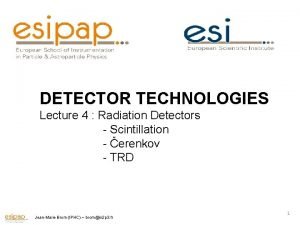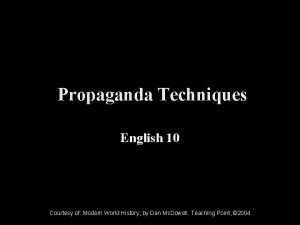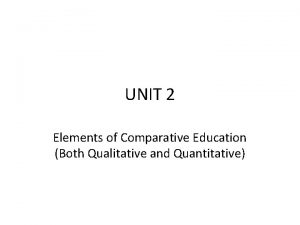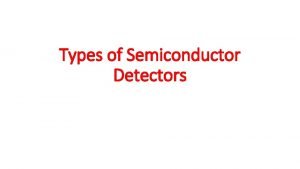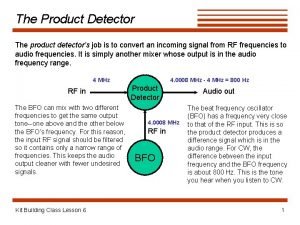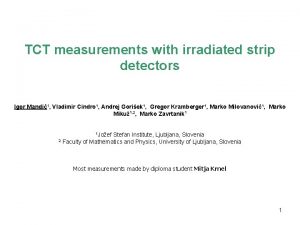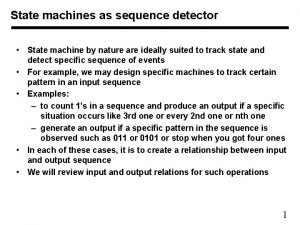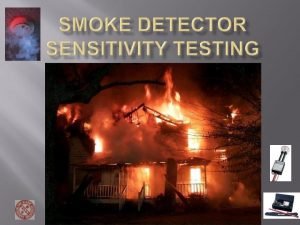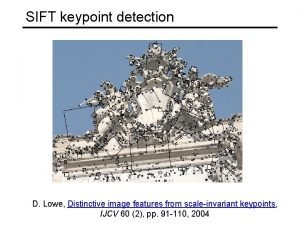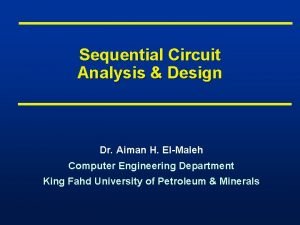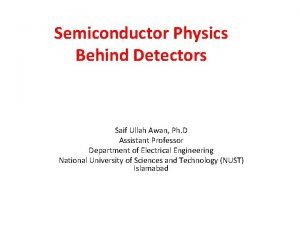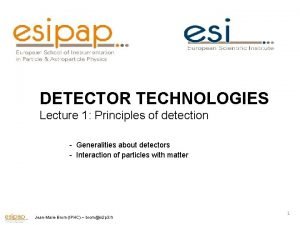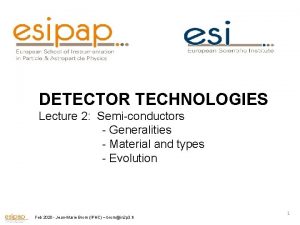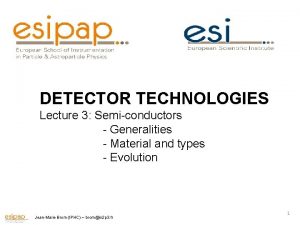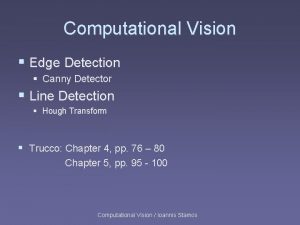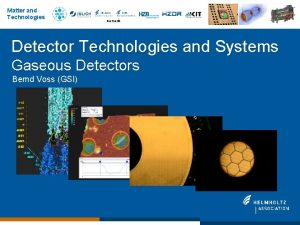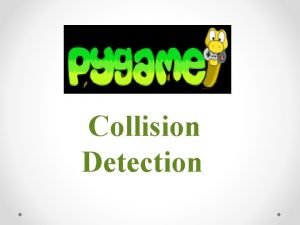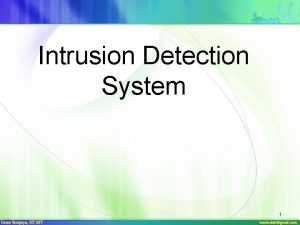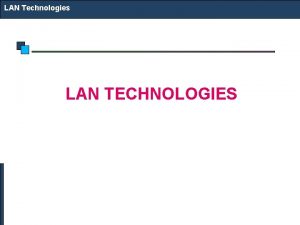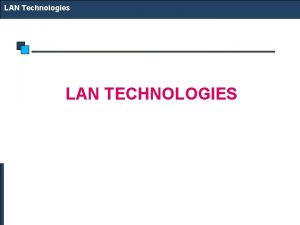DETECTOR TECHNOLOGIES Lecture 1 Principles of detection Generalities



































- Slides: 35

DETECTOR TECHNOLOGIES Lecture 1: Principles of detection - Generalities about detectors - Interaction of particles with matter Jean-Marie Brom (IPHC) – brom@in 2 p 3. fr 1

Goal : Observation and identification of final states (whatever the processus) A particle : Mass Electrical Charge Moment Energy Lifetime (spin, flavour, color…. ) A Detector : does not give any measurement. Gives an information coming after an interaction with the particle Jean-Marie Brom (IPHC) – brom@in 2 p 3. fr 2

Energy deposition - Limited (the particle goes almost undisturbed) Momentum Electrical charge (if magnet) Trajectography - Total (the particle stops) Energy Various processes But first : some important notions (supposed to be known ? ) Jean-Marie Brom (IPHC) – brom@in 2 p 3. fr 3

Types of detectors : Trackers (position and momentum measurement) Calorimeters (energy measurement) Identifiers (identification of various types of particles) Trigger counters Jean-Marie Brom (IPHC) – brom@in 2 p 3. fr 4

CROSS SECTION : Probability of a phenomenon (interaction with the detector) to occur. F = incident flux of particles Ns = emitted number of particles Ω = Solid angle MEAN FREE PATH : Average distance travelled by a particle between 2 consecutive interactions in matter (detector) : σ = total interaction cross section n = number of interactive centers per unit volume Jean-Marie Brom (IPHC) – brom@in 2 p 3. fr 5

Jean-Marie Brom (IPHC) – brom@in 2 p 3. fr 6

High energetic particle (particles at speed ≈ c quasi-transparent detector Jean-Marie Brom (IPHC) – brom@in 2 p 3. fr Particle c (cm) ∞ (stable) e+ / e - ∞ (stable) µ 6. 6 10 4 neutrino ∞ (stable) πO 2. 5 10 -6 π+ / π- 780 K+ / K - 371 K 0 s 2. 7 K 0 l 1554 p ∞ (stable) n 2. 7 10 13 7

INTERACTION OF PARTICLE WITH MATTER : Depends on the type of interactions ELECTROMAGNETIC : λ ≈ µm ionization pairs creation (e+ e-, electrons – holes…) photon emission (Bremstrahlung, Cerenkov effect) STRONG : λ ≈ cm hadronic showers of neutrons (but the observed signal will be due to EM interaction) WEAK : λ ≈ 1015 m (neutrinos) GRAVITY : ? ? Depends on the type of particle CHARGED NEUTRAL And of course, ENERGY, MEAN FREE PATH, LIFETIME Jean-Marie Brom (IPHC) – brom@in 2 p 3. fr 8

In order to detect a particle, it must - interact with the material of the detector - transfer some energy in a recognizable way (signal to be processed) 4 CLASSES OF PARTICLES 3 POSSIBILITIES Heavy (m > me ) charged particles Light (m ≈ me ) charged particles Photons Hadrons Ionization (EM) Radiation (EM) Nuclear interaction (Strong) Jean-Marie Brom (IPHC) – brom@in 2 p 3. fr 9

HEAVY (m > me ) CHARGED PARTICLES : IONIZATION Energy loss (energy transferred to the medium ) by ionization in Me. V g-1 cm 2 Bethe-Bloch, 1932 Where : K = 4 π NA re 2 me = 0. 3071 A, Z : atomic mass and number relative to the medium NA : Avogadro’s number Tmax : maximum possible energy transferred to an electron in the medium (see J. Collot’s lecture) z : charge of the incoming particle , : relatives to the particle → d. E/d. X in Me. V. g-1. cm 2 → valid only for M>m → d. E/d. X depends on , → d. E/d. X does not depend on M Jean-Marie Brom (IPHC) – brom@in 2 p 3. fr 10

HEAVY (m > me ) CHARGED PARTICLES : IONIZATION Non-relativistic = p/m < 1 -d. E/dx α 5/3 Relativistic increase > 4 -d. E/dx α 2 ln( ) ≈ 4 Minimum Ionizing Particle (MIP) Jean-Marie Brom (IPHC) – brom@in 2 p 3. fr 11

HEAVY (m > me ) CHARGED PARTICLES : IONIZATION Relativistic rise : - more distant collisions, increasing the transverse electric field with - Typical for gas : 1. 5 liquid : 1. 1 Jean-Marie Brom (IPHC) – brom@in 2 p 3. fr 12

HEAVY (m > me ) CHARGED PARTICLES : IONIZATION Direct identification by energy loss in Ne-CO 2 90 -10 % (ALICE TPC) Direct identification by energy loss in Ar-CH 4 80 -20 % (DELPHI Jean-Marie Brom (IPHC) – brom@in 2 p 3. fr 13

HEAVY (m > me ) CHARGED PARTICLES : IONIZATION Corrections to the Bethe-Bloch formula : Density effect : the density of the medium will have a screening effect on the relativistic rise (important for solids and liquids) Solids Liquids Gaz Jean-Marie Brom (IPHC) – brom@in 2 p 3. fr 14

LIGTH (m≈me) CHARGED PARTICLES : IONIZATION Corresponds to an energy loss by charged particle : Bethe-Bloch But : small mass : electrons may be deflected interaction electron – electron : collisions between identical particles Bethe-Bloch : Bethe-Bloch For electrons Jean-Marie Brom (IPHC) – brom@in 2 p 3. fr 15

CHARGED PARTICLES : RADIATION (Bremsstrahlung) For any charged particle : When accelerated (or deccelerated), in the nucleus electrical field, any charged particle emits photons From : Bethe, H. A. , Heitler, W. , 1934. On the stopping of fast particles and on the creation of positive electrons Z : médium z, m, E : particle Up to 100 Ge. V, on can neglect the Bremssttrahlung if particle ≠ e+ or e- Jean-Marie Brom (IPHC) – brom@in 2 p 3. fr 16

CHARGED PARTICLES : RADIATION (Bremsstrahlung) For electrons, Can be rewritten as Xo : radiation length (characteristic of the medium) Jean-Marie Brom (IPHC) – brom@in 2 p 3. fr Medium Xo (g cm-2) Hydrogen 63. 1 Helium 94. 3 Carbon 42. 7 Aluminium 24. 0 Iron 13. 8 17

CONSEQUENCE : CRITICAL ENERGY The energy loss has 2 components : - ionization (for heavy and energetic particles, it is ≈ constant - radiation ( for heavy particles, it is almost negligible) proportional to E The critical energy (Ec) is defined as the energy at which the two mechanisms are equal For liquids and solids Jean-Marie Brom (IPHC) – brom@in 2 p 3. fr For gas 18

Note : table for electrons only (the most sensitive) for other particles, it would scale to the square of the particle mass Jean-Marie Brom (IPHC) – brom@in 2 p 3. fr 19

INTERACTION OF CHARGED PARTICLES Jean-Marie Brom (IPHC) – brom@in 2 p 3. fr 20

CHARGED PARTICLES (Hadrons) : Coulomb scattering and interactions Hadrons are interacting mainly with the nucleus by (strong interaction) - collisions (coulomb)) - interaction (strong force) X Phenomenon governed by the interaction lengths λT (collisions) and λi (interactions) Jean-Marie Brom (IPHC) – brom@in 2 p 3. fr 21

Range : measured of the stopping power for various material for different energies (momentum) Jean-Marie Brom (IPHC) – brom@in 2 p 3. fr 22

Hadronic shower : λ instead of Xo Jean-Marie Brom (IPHC) – brom@in 2 p 3. fr 23

CONSEQUENCE : RANGE IN MATTER In a medium a particle will loose its energy by any means (ionization radiation, scattering) until it stops in the medium Of course, it depens on the MASS and ENERGY of the incoming particle Of course, it depens on the DENSITY and the THICKNESS of the medium Almost negligible for High Energy Physics Jean-Marie Brom (IPHC) – brom@in 2 p 3. fr 24

ENERGY LOSS DISTRIBUTION The Bethe-Bloch formula describes the average energy loss of charged particles. But there can be large fluctuations which have an effect on larger energy losses The fluctuation around the mean is decribed by an asymetric distribution Landau distribution : In fact, for thin absorbers, the reality is more a convolution of a Landau and a Gaussian distribution… Energy deposited by 736 Me. V/c proton in Silicon (Xo = 9. 4 cm , Ec = 39 Me. V for electrons) Jean-Marie Brom (IPHC) – brom@in 2 p 3. fr 25

INTERACTION OF PHOTONS Jean-Marie Brom (IPHC) – brom@in 2 p 3. fr 26

INTERACTION OF PHOTONS : PHOTOELECTRIC EMISSION +A A. Einstein, 1905 A + + e- Again : Energy transfert to an electron : Ee = E - Ebinding Dominant process for E < 100 ke. V Jean-Marie Brom (IPHC) – brom@in 2 p 3. fr 27

INTERACTION OF PHOTONS : COMPTON SCATTERING h ’ h Θe can not be > /2 Cross section : calculated using QED : Klein – Nishima formula e e. T Intergating over Ω : σCompton = σCompton α Z / E Jean-Marie Brom (IPHC) – brom@in 2 p 3. fr 28

INTERACTION OF PHOTONS : PAIRS PRODUCTION e- + e+ Needs a nucleus or another electron… Threshold : And because m nucleus >> m e Cross section : For higher energies ( > 10 Me. V) : Note : If enough energy, the positron will annihilate with another electron, producing another photon, which will annihilate in a pair … Electromagnetic shower Jean-Marie Brom (IPHC) – brom@in 2 p 3. fr 29

Jean-Marie Brom (IPHC) – brom@in 2 p 3. fr 30

INTERACTION OF PHOTONS : PAIRS PRODUCTION Note : If enough energy, the positron will annihilate with another electron, producing another photon, which will annihilate in a pair … Electromagnetic shower The ATLAS electromagnetioc calorimeter Jean-Marie Brom (IPHC) – brom@in 2 p 3. fr 31

CERENKOV EMISSION When a particle is moving faster than the velocity of ligth in a given medium production of photons Treshold : (n is the refractive index of the medium) Photon production is rather small : Energy loss is very small (can be neglected): 10 -3 Me. V. cm 2. g-1 for solids 0. 01 – 0. 2 Me. V. cm 2. g-1 for He, H 2 Typical : 0. 35 µm < λ cerenkov < 0. 55 µm Jean-Marie Brom (IPHC) – brom@in 2 p 3. fr 32

Identification of particles by measurement of Θ Jean-Marie Brom (IPHC) – brom@in 2 p 3. fr (Experience Babar) 33

TRANSITION RADIATION Transition radiation is a photon emission (X) occuring when a charged particle passes through inhomogeneous media, such as a boundary between two different media with different dielectric properties Emission at an angle Very low rate In the momentum range 1 – 10 Ge. V, only electrons produce transition radiation with a relatively low probablity (1%) per boundary crossing. Thus, a TRD is mostly used for electron identification. Jean-Marie Brom (IPHC) – brom@in 2 p 3. fr 34

Jean-Marie Brom (IPHC) – brom@in 2 p 3. fr 35
 Hpdcms
Hpdcms 01:640:244 lecture notes - lecture 15: plat, idah, farad
01:640:244 lecture notes - lecture 15: plat, idah, farad Example of propaganda advertisement
Example of propaganda advertisement Testimonial propaganda
Testimonial propaganda Snob appeal propaganda
Snob appeal propaganda Examples of name-calling
Examples of name-calling Animal farm bandwagon
Animal farm bandwagon Persuasive propaganda techniques
Persuasive propaganda techniques Persuasive techniques transfer
Persuasive techniques transfer Bandwagon propaganda techniques
Bandwagon propaganda techniques Persuasive techniques examples in advertising
Persuasive techniques examples in advertising Splenda
Splenda Card stacking example sentence
Card stacking example sentence Analyzing persuasive techniques
Analyzing persuasive techniques Glittering generalities advertising
Glittering generalities advertising Glittering generalities definition
Glittering generalities definition Plain folks
Plain folks Appeal to emotion
Appeal to emotion Card stacking persuasive technique
Card stacking persuasive technique What technique
What technique Plain folks definition and examples
Plain folks definition and examples Propaganda techniques answer key
Propaganda techniques answer key Principles of economics powerpoint lecture slides
Principles of economics powerpoint lecture slides Principles of lecture method
Principles of lecture method Detector building science olympiad cheat sheet
Detector building science olympiad cheat sheet Diffused junction detector
Diffused junction detector Product detector circuit
Product detector circuit Spaghetti detector
Spaghetti detector Sequence detector examples
Sequence detector examples Walter jaeger smoke detector
Walter jaeger smoke detector David g lowe
David g lowe Sequence detector 1101
Sequence detector 1101 Disadvantages of semiconductor detector
Disadvantages of semiconductor detector Cci controls lp gas detector
Cci controls lp gas detector Smoke detector mounting tape
Smoke detector mounting tape Plagio detector spider
Plagio detector spider
